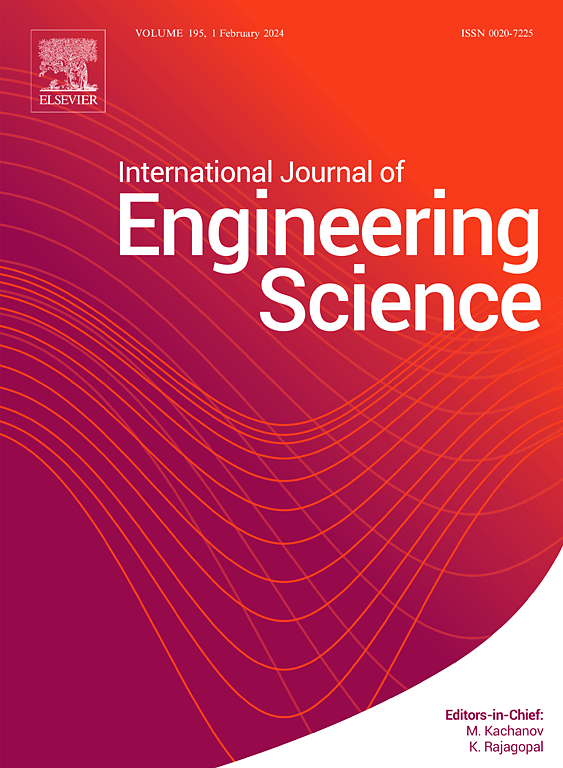包含之字形梁的三角形晶格弯曲的微极板模型
IF 5.7
1区 工程技术
Q1 ENGINEERING, MULTIDISCIPLINARY
International Journal of Engineering Science
Pub Date : 2025-05-29
DOI:10.1016/j.ijengsci.2025.104312
引用次数: 0
摘要
由之字形梁组成的等边三角形晶格是一种典型的具有手性单元格的周期结构。这些材料的面内变形被认为表现出手性效应,但面外弯曲从未被探索过。在这里,我们开发了一个连续体模型来描述这些晶格的整体弯曲行为,通过将它们均匀化为微极板。在不需要任何特别的运动学假设的情况下,以渐近的方式导出了板的控制方程,并通过施加广义Hill-Mandel条件从单元胞解析确定了有效弹性参数。与以往的研究不同,我们发现在面内和面外变形中都没有手性效应。此外,通过两个无约束弯曲和约束弯曲的例子,我们证明了通过改变梁的之字形角或截面长宽比,晶格的曲率可以在抗裂和共裂之间转换。所得结果与晶格的有限元模拟结果非常吻合。本文章由计算机程序翻译,如有差异,请以英文原文为准。
A micropolar plate model for bending of triangular lattices comprising zigzag beams
Equilateral triangle lattices comprising zigzag beams are a typical kind of periodic structures with chiral unit cells. The in-plane deformation of these materials was believed to exhibit chiral effect, but the out-of-plane bending has never been explored. Here, we develop a continuum model to describe the overall bending behavior of such lattices by homogenizing them as micropolar plates. The governing equations of the plate are derived in an asymptotic way with no need of any ad hoc kinematic assumptions, and the effective elastic parameters are determined analytically from the unit cell by imposing the generalized Hill-Mandel condition. Different from the previous study, we find that there are no chiral effects in both the in-plane and out-of-plane deformations. Moreover, with two examples for unconstrained and constrained bending, we show that the curvature of the lattice can be transformed between anticlastic and synclastic by changing the zigzag angle or the sectional aspect ratio of the beams. The results agree excellent with finite element simulations of the lattice.
求助全文
通过发布文献求助,成功后即可免费获取论文全文。
去求助
来源期刊

International Journal of Engineering Science
工程技术-工程:综合
CiteScore
11.80
自引率
16.70%
发文量
86
审稿时长
45 days
期刊介绍:
The International Journal of Engineering Science is not limited to a specific aspect of science and engineering but is instead devoted to a wide range of subfields in the engineering sciences. While it encourages a broad spectrum of contribution in the engineering sciences, its core interest lies in issues concerning material modeling and response. Articles of interdisciplinary nature are particularly welcome.
The primary goal of the new editors is to maintain high quality of publications. There will be a commitment to expediting the time taken for the publication of the papers. The articles that are sent for reviews will have names of the authors deleted with a view towards enhancing the objectivity and fairness of the review process.
Articles that are devoted to the purely mathematical aspects without a discussion of the physical implications of the results or the consideration of specific examples are discouraged. Articles concerning material science should not be limited merely to a description and recording of observations but should contain theoretical or quantitative discussion of the results.
 求助内容:
求助内容: 应助结果提醒方式:
应助结果提醒方式:


